Adding Logging in Entity Framework Core
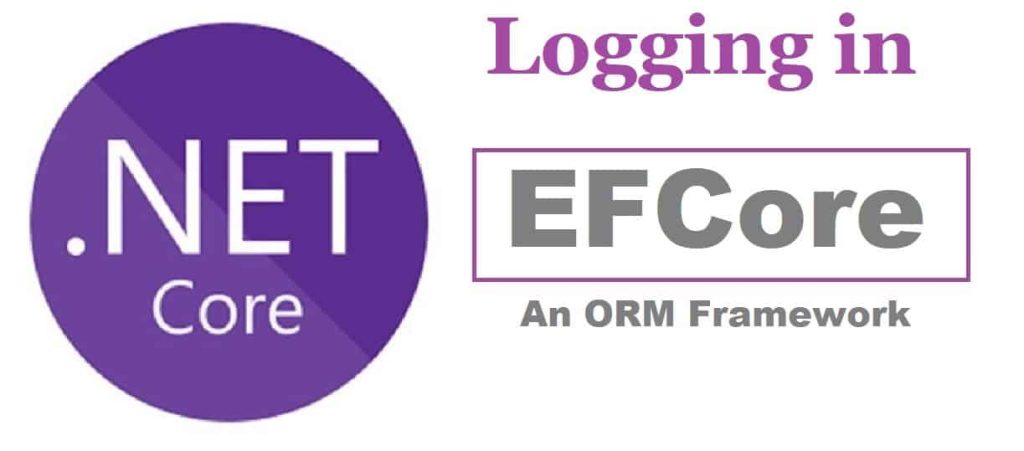
In this article, we will see how to enable or Logging in Entity Framework Core.
We often find such needs where we need to log SQL CRUD commands and queries getting executed for Debugging or Informational or troubleshooting purposes in EF Core.
Today in this article, we will cover below aspects,
In this article, we shall two basic techniques of enabling the logging in Entity framework core commands execution.
Both these techniques can be applied to ASP.NET Core or Console or any Desktop application(based on .NET Core).
- Logging through Configuration (No code change required)
- Logging using LoggerFactory
Getting Started
I already have a sample .NET Core application that uses DBContext as below.
References: Getting Started with Entity Framework .NET Core
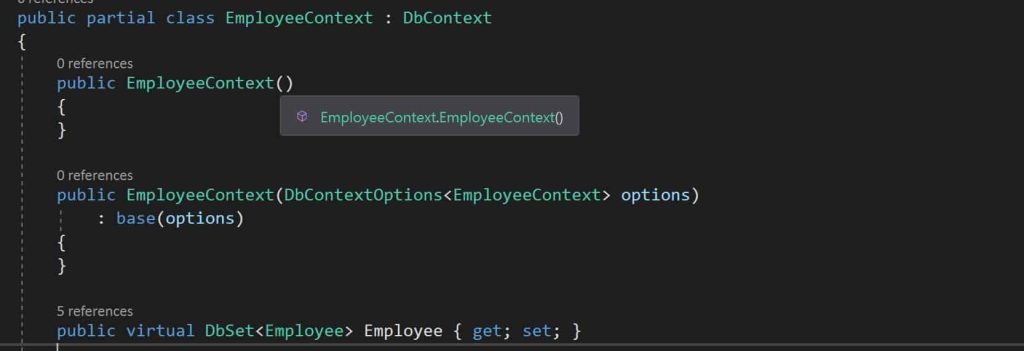
Now you may access DBContext using Dependency injection or accessing it directly, either way, below both discussed techniques, work fine.
Logging in Entity Framework Core Enable – Configuration
Please note that Entity Framework Core has built in the logging support in .NET Core once required EF components are installed in the applications.
Let’s use the ‘appsettings.json‘ Configuration as below,
"Microsoft.EntityFrameworkCore": "Information"
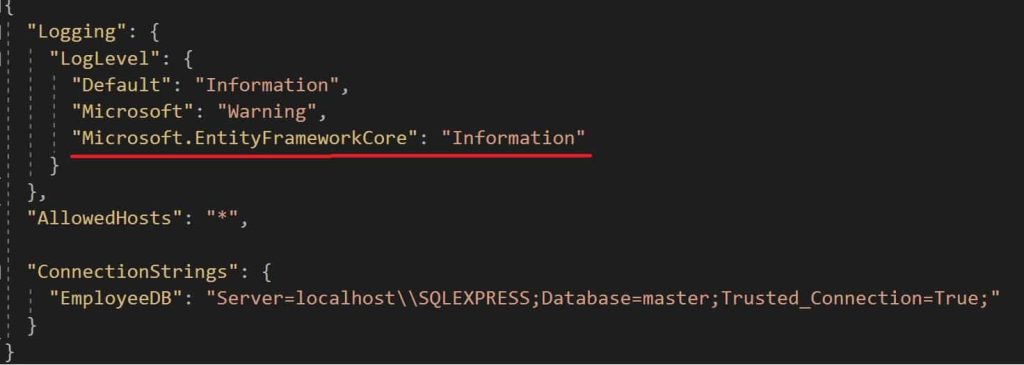
The above configuration can be enabled for debugging, Information or Warning, etc. Log level type as needed.
Let execute any CRUD operation, you shall see magically all the logs are getting captured on based on the logging configuration you have enabled.
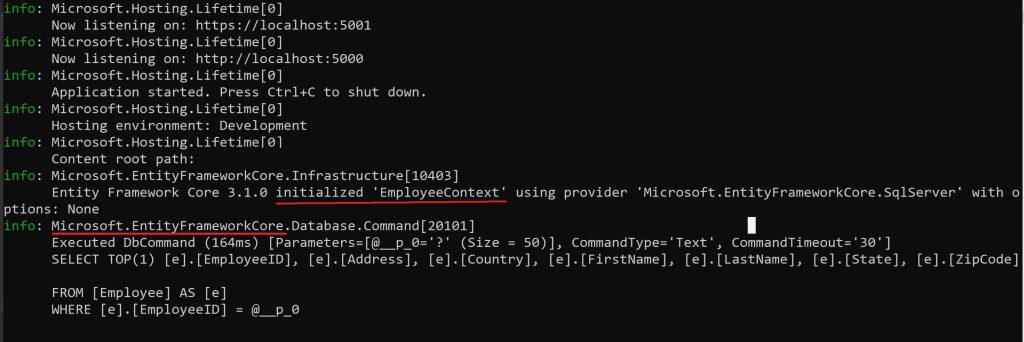
The above approach works fine seamlessly for ASP.NET Core applications.
Applications like Console, and Windows Form applications if using Dependency Injection the above configuration will work too.
Please make sure to enable logging configuration in the IoC container.
Please refer to a few articles on Implementing DI in a Console application and Windows Form application for understanding more on the same.
To use this option , please make sure to enable your DBContext class using DbContextOptions. This option make sure configurations are loaded from apps settings.

If using EFCore Scaffolding commands to generate the scaffolding then DbContextOptions gets added by default.
Enable logging using LoggerFactory
In this example, we shall create a static instance of the LoggerFactory class then we will pass this object in the OnConfiguring and invoke Method UseLoggerFactory().
public partial class EmployeeContext : DbContext
{
public static readonly ILoggerFactory _loggerFactory = LoggerFactory.Create(builder =>
{
builder.AddConsole();
});
public EmployeeContext()
{
}
public EmployeeContext(DbContextOptions<EmployeeContext> options)
: base(options)
{
}
..
}
Above we have enabled console logging. If needed please use a few additional options for creating logging.
Update the OnConfiguring () by adding UseLoggerFactory() using the above created _loggerFactory instance.
protected override void OnConfiguring(DbContextOptionsBuilder optionsBuilder)
{
optionsBuilder.UseLoggerFactory(_loggerFactory);
optionsBuilder.EnableSensitiveDataLogging();
if (!optionsBuilder.IsConfigured)
{
optionsBuilder.UseSqlServer("Server=localhost\\SQLEXPRESS;Database=master;Trusted_Connection=True;");
}
}
Let’s run any CRUD operation on the DBContext object, You shall see the result as below,
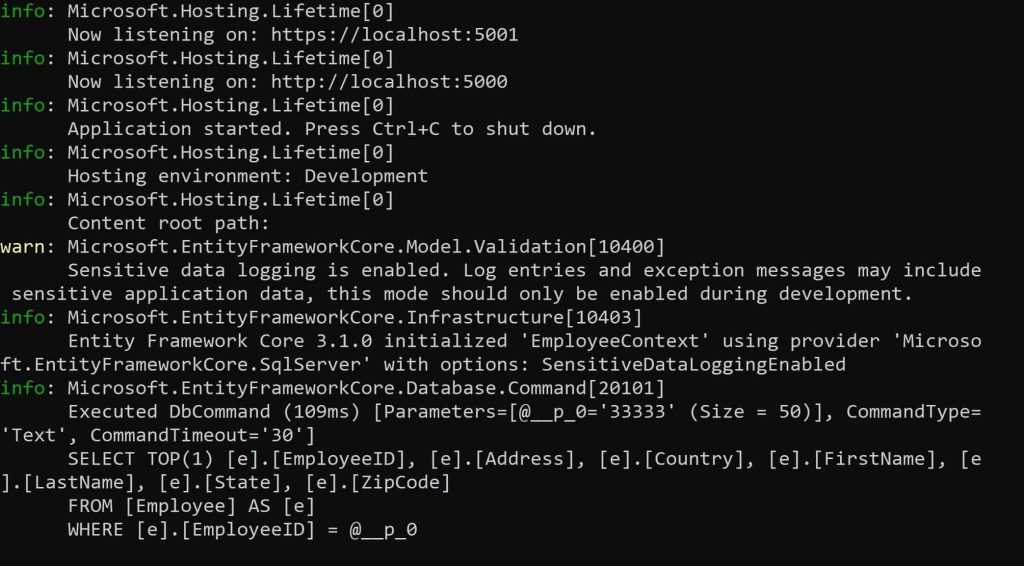
It’s recommended using static singleton instance of LoggerFactory object for all database operations.
That’s all! Happy coding!
Does this help you fix your issue?
Do you have any better solutions or suggestions? Please sound off your comments below.
Summary
We often find needs for logging SQL CRUD commands or queries getting executed for Debugging or Informational or troubleshooting purposes in EF Core. In this article, we looked at enabling logging in the Entity Framework layer using simple easy steps.
Please bookmark this page and share it with your friends. Please Subscribe to the blog to receive notifications on freshly published(2024) best practices and guidelines for software design and development.